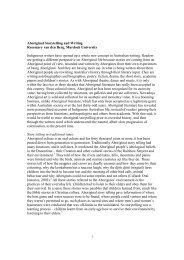Gallipoli, Kokoda and the Making of National Identity - [API] Network
Gallipoli, Kokoda and the Making of National Identity - [API] Network
Gallipoli, Kokoda and the Making of National Identity - [API] Network
Create successful ePaper yourself
Turn your PDF publications into a flip-book with our unique Google optimized e-Paper software.
Hank Nelson<br />
The crowd, eager to scramble for vantage points, was not anxious to hear what<br />
was being said. Perhaps half <strong>of</strong> <strong>the</strong>m did not have adequate English to follow <strong>the</strong><br />
details <strong>of</strong> <strong>the</strong> speeches <strong>and</strong> in any case much <strong>of</strong> what <strong>the</strong> visitors said was directed<br />
to a larger audience not present — <strong>the</strong> home country audience <strong>of</strong> television, radio<br />
<strong>and</strong> newspaper readers. Such is <strong>the</strong> capacity <strong>of</strong> <strong>the</strong> media to cross instantly national<br />
borders that a national leader wanting to talk for more than twenty seconds to his<br />
own people is best able to do this by exploiting an <strong>of</strong>fshore exotic location. He is<br />
abetted by <strong>the</strong> fact that <strong>the</strong> media owners, having paid dearly to have <strong>the</strong>ir reporters<br />
travel with <strong>the</strong> <strong>of</strong>ficial party, want a return on <strong>the</strong>ir investment. At Ela Beach many<br />
in <strong>the</strong> crowd talked quietly to neighbours <strong>and</strong> nearly all took a close interest in <strong>the</strong><br />
ceremonial guard. Every now <strong>and</strong> again someone in <strong>the</strong> guard swayed <strong>and</strong> crumpled<br />
in <strong>the</strong> heat. The crowd with communal sighs <strong>and</strong> clicking <strong>of</strong> tongues expressed<br />
<strong>the</strong>ir sympathy: ‘Ah, tuhat, tuhat (too hot)’. But <strong>the</strong> crowd was clearly pleased that<br />
it was Australians who sagged <strong>and</strong> sprawled <strong>and</strong> not Melanesians. Then <strong>the</strong>re was<br />
a sudden shout, ‘Wanpela wait meri paldaun!’ All strained to see. It was true that<br />
from among <strong>the</strong> triservices, bigender Australian squad a woman had collapsed. So<br />
here were national leaders addressing a dense crowd, redefining great national <strong>the</strong>mes<br />
<strong>and</strong> <strong>the</strong> crowd was watching but not listening. The crowd was <strong>the</strong>re for <strong>the</strong> panning,<br />
locating shot, just like <strong>the</strong> palm trees along Ela Beach road.<br />
The next day Keating flew across <strong>the</strong> Owen Stanleys <strong>and</strong> at <strong>the</strong> <strong>Kokoda</strong><br />
monument he provided <strong>the</strong> visual image <strong>and</strong> <strong>the</strong> condensed statement that dominated<br />
Australian media on 26 <strong>and</strong> 27 April. He knelt <strong>and</strong> his lips <strong>and</strong> <strong>the</strong> garl<strong>and</strong> <strong>of</strong><br />
flowers around his neck brushed <strong>the</strong> foot <strong>of</strong> a monument. In his speech Keating<br />
said that if <strong>the</strong> Australian nation was founded at <strong>Gallipoli</strong> <strong>the</strong>n its ‘depth <strong>and</strong> soul’<br />
were confirmed in its defence at <strong>Kokoda</strong>. 7 At <strong>Kokoda</strong>, Keating said, <strong>the</strong> Australians<br />
had fought not for <strong>the</strong> ‘mo<strong>the</strong>r country’ but to secure Australia <strong>and</strong> an Australian<br />
way <strong>of</strong> life. On that small plateau at <strong>Kokoda</strong> with <strong>the</strong> vast backdrop <strong>of</strong> <strong>the</strong> Owen<br />
Stanleys, Keating claimed to find a spiritual basis to <strong>the</strong> Australian nation. 8<br />
Through 1993, 1994 <strong>and</strong> 1995 <strong>the</strong> fiftieth anniversaries <strong>of</strong> <strong>the</strong> second world war<br />
continued. The unknown soldier came home in November 1993 <strong>and</strong> Australians<br />
followed his progress from <strong>the</strong> western front, to temporary rest in old parliament<br />
house, on a last slow march up Anzac Parade, <strong>and</strong> to his final internment at <strong>the</strong><br />
Australian war memorial. The audience present <strong>and</strong> those reached by <strong>the</strong> media<br />
were told that he was one <strong>of</strong> ‘<strong>the</strong> 100,000 Australians who have died in wars this<br />
century. He is all <strong>of</strong> <strong>the</strong>m. And he is one <strong>of</strong> us’. 9 Old soldiers went back to<br />
battlefields in Europe, North Africa, <strong>the</strong> Middle East, Sou<strong>the</strong>ast Asia <strong>and</strong> <strong>the</strong> Pacific.<br />
Monuments, especially <strong>of</strong> Weary Dunlop <strong>and</strong> to <strong>the</strong> dead <strong>of</strong> <strong>the</strong> S<strong>and</strong>akan death<br />
march, were unveiled. The commemorations culminated in eleven months <strong>of</strong> recall,<br />
recreation <strong>and</strong> recollection: ‘Australian Remembers 1945-1995’. Anzac day 1995<br />
was a popular, stately folk festival. In Melbourne a forest <strong>of</strong> crosses spread across<br />
<strong>the</strong> lawns near <strong>the</strong> shrine <strong>of</strong> remembrance — a paddock <strong>of</strong> remembering — <strong>and</strong> in<br />
Canberra <strong>the</strong> children who climbed trees to see <strong>the</strong> march were born at least ten<br />
years after <strong>the</strong> last Australian soldier came home from Vietnam. Newspapers<br />
produced liftout after liftout; <strong>the</strong> Andrews sisters, Vera Lynn <strong>and</strong> Glenn Miller were<br />
heard by larger radio audiences than ever before; more Australians saw cuts from<br />
cinesound <strong>and</strong> movietone newsreels than in <strong>the</strong> years in which <strong>the</strong>y were made;<br />
1940s jeeps <strong>and</strong> trucks ground <strong>the</strong>ir way up <strong>the</strong> ‘track’ to Darwin, restored search<br />
152


![Gallipoli, Kokoda and the Making of National Identity - [API] Network](https://img.yumpu.com/31766380/5/500x640/gallipoli-kokoda-and-the-making-of-national-identity-api-network.jpg)
![Dream and Nightmare in William Gibson's ... - [API] Network](https://img.yumpu.com/49298598/1/184x260/dream-and-nightmare-in-william-gibsons-api-network.jpg?quality=85)

!['Fuck All Editors': The Ern Malley Affair and Gwen ... - [API] Network](https://img.yumpu.com/42446228/1/184x260/fuck-all-editors-the-ern-malley-affair-and-gwen-api-network.jpg?quality=85)
![Polona Petek - [API] Network](https://img.yumpu.com/40542952/1/190x245/polona-petek-api-network.jpg?quality=85)
![to download as a PDF. - [API] Network](https://img.yumpu.com/35170825/1/184x260/to-download-as-a-pdf-api-network.jpg?quality=85)
![Edward Koiki Mabo: The Journey to Native Title - [API] Network](https://img.yumpu.com/33197148/1/184x260/edward-koiki-mabo-the-journey-to-native-title-api-network.jpg?quality=85)
![Indigenous Knowledge and Pharmaceuticals - [API] Network](https://img.yumpu.com/24108846/1/184x260/indigenous-knowledge-and-pharmaceuticals-api-network.jpg?quality=85)
![Ferals: Terra-ism and Radical Ecologism in Australia - [API] Network](https://img.yumpu.com/13809010/1/184x260/ferals-terra-ism-and-radical-ecologism-in-australia-api-network.jpg?quality=85)
![Big Chief Little Wolf: Wrestling, Radio and Folklore in ... - [API] Network](https://img.yumpu.com/12204748/1/184x260/big-chief-little-wolf-wrestling-radio-and-folklore-in-api-network.jpg?quality=85)
![Dark Tourism and the Celebrity Prisoner - [API] Network](https://img.yumpu.com/4348795/1/184x260/dark-tourism-and-the-celebrity-prisoner-api-network.jpg?quality=85)